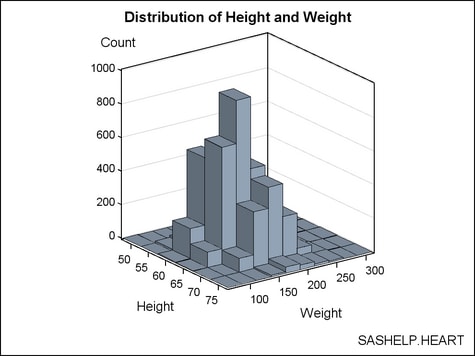Example Program and Statement Details
Example Program
proc template;
define statgraph bihistogram;
begingraph;
entrytitle "Distribution of Height and Weight";
entryfootnote halign=right "SASHELP.HEART";
layout overlay3d / cube=false zaxisopts=(griddisplay=on);
bihistogram3dparm x=height y=weight z=count / display=all;
endlayout;
endgraph;
end;
run;
data heart;
set sashelp.heart(keep=height weight);
if height ne . and weight ne .;
height=round(height,5);
weight=round(weight,25);
run;
proc summary data=heart nway completetypes;
class height weight;
var height;
output out=stats(keep=height weight count) N=Count;
run;
proc sgrender data=stats template=bihistogram;
run;
Statement Summary
The BIHISTOGRAM3DPARM
statement does not perform a binning computation on the input columns.
Thus, you must pre-bin the data. In addition, input data for the statement
must be binned by both X and Y. That is, the values for the X column
and the Y column must form a complete, rectangular grid of bins. Input
data with non-binned columns should be preprocessed with PROC KDE
(SAS/STAT), which enables you to set the number of bins for X and
Y. Or the data can be preprocessed with a technique similar to the
example, where a pre-defined bin width is used.
The input
data for Z= column must be nonnegative. In the graph display, the
direction of the Z axis is upwards rather than outwards.
Options
specifies whether to
use bins as the basis for the X and Y axis tick marks.
Standard axes are used,
ignoring bin boundaries and midpoints set by the ENDLABELS= option.
The ENDLABELS= option determines how the axis ticks
and value labels are displayed. Some axis options for the X- and Y-axes might
not apply.
Interaction: For this option to take effect, this plot must be the primary plot
in the parent OVERLAY3D layout. For more information, see the PRIMARY= option.
specifies whether labels
are drawn at the endpoints of the X bins and Y bins.
Interaction: For this option to take effect, this plot must be the primary plot
in the parent OVERLAY3D layout. For more information, see the PRIMARY= option.
specifies the appearance
of the filled bins. See General Syntax for Attribute Options for the syntax
on using a style-element and Fill Options for available fill-options.
specifies the appearance
of the bin outlines. See General Syntax for Attribute Options for the syntax
on using a style-element and Line Options for available line-options.
specifies that the
data columns for this plot and the plot type be used for determining
default axis features.
Details: This option is needed only when two or more plots within an overlay-type
layout contribute to a common axis. For more information, see When Plots Share Data and a Common Axis.
